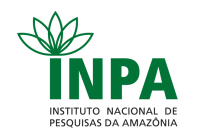Corpo Discente - Egressos
Luna Alcântara Neres de Carvalho
| Título | AVALIAÇÃO DA ATIVIDADE E MECANISMOS DE AÇÃO ANTILEUCÊMICA DO EXTRATO HIDROETANÓLICO DAS FOLHAS DE Cochlospermum orinocense (KUNTH) STEUD | ||||||||||||||||||||||||
| Data da Defesa | 26/04/2024 | ||||||||||||||||||||||||
| Download | Em sigilo | ||||||||||||||||||||||||
Banca
| |||||||||||||||||||||||||
| Palavras-Chaves | extrato; antitumoral; citotoxicidade; células Jurkat; Cochlospermum orinocense. | ||||||||||||||||||||||||
| Resumo | O câncer é considerado um dos mais importantes problemas de saúde pública mundial, o que desperta o interesse na pesquisa e desenvolvimento de fármacos com atividadeantitumoral. Diversas plantas medicinais podem ser uma fonte de novos fármacos, como a Cochlospermum orinocense (Kunth) Steud. Desta forma, o presente estudo tem como objetivoavaliar o potencial citotóxico e antineoplásico do extrato hidroetanólico de C. orinocense (EHFCo), e estabelecer o perfil fitoquímico do extrato. As Análises fitoquímicas do EHFCo foi analisada empregando um sistema de HPLC (LC- 20A Prominence, Shimadzu®, Japão). A avaliação do potencial citotóxico ea seletividade do EHFCo (0,78 - 200 µg/mL) foi determinada em células Jurkat e células mononucleares de sangue periférico humano (PBMC), nos tempos 24, 48 e 72 h. Utilizando a resazurina (440 µM), após o qual, as placas foram lidas em 540 nm (estado oxidado) e 620nm (estado reduzido) em espectofotômetro leitor de microplacas. Após o tratamento de células Jurkat com o EHFCo, as CI50 determinadas foram de 29,00 ±1,00 24 h, 25,00±1, 00 e 26,00 ±1, 00 µg/mL, nos tempos de 24, 48 e 72 h, respectivamente. Nossos resultados mostraram que o valor de CI50 do EHFCo no PBMC no tempo de 24 e 48 horas não foi possível calcular, sendo superior a 100 µg/mL, e no tempo de 72 horas esse valor de CI50 foi de 66,65 µg/mL. O EHFCo apresentou índice de seletividade (IS) > 2 em todos os tempos testados. Na avaliação da atividade da composição fitoterápica sob os perfis de DNA (G0\G1, S, G2\M e apoptose), pelo ensaio do ciclo celular, utilizando iodeto de propídio (IP), em células Jurkat tratadas com a CI50 (25 µg/mL) do EHFCo, mostrou que o extrato induziu 32,65 % morte celular na fase SubG1. Na confirmação dos casos de apoptose em células Jurkat, expostas por 48 h ao tratamento com a CI50 do EHFCo, houve uma elevada proporção de células marcadas com Anexina-V+/IPe Anexina-V+/IP+ (52,79%), indicando que, nesta concentração, a composição induz a apoptose. A análise química preliminar do EHFCo por HPLC identificou as presenças de alguns compostos fenólicos como ácido p-cumárico, rutina e quercetina. Esses compostos possivelmente estao relacionados com a atividade antileucêmica do extrato. O EHFCo apresentou potencial antitumoral sobre a linhagem celular Jurkat. Observou-se que o extrato apresenta seletividade para a linhagem Jurkat, induzindo citotoxicidade. | ||||||||||||||||||||||||
| Abstract | Cancer is considered one of the most important public health problems worldwide, which arouses interest in the research and development of drugs with antitumor activity. Several medicinal plants can be a source of new drugs, such as Cochlospermum orinocense (Kunth) Steud. Thus, the present study aims to evaluate the cytotoxic and antineoplastic potential of the hydroethanolic extract of C. orinocense (EHFCo), and to establish the phytochemical profile of the extract. Phytochemical analysis of EHFCo was analyzed using an HPLC system (LC- 20A Prominence, Shimadzu®, Japan). The evaluation of the cytotoxic potential and the selectivity of EHFCo (0.78 - 200 µg/mL) was determined in Jurkat cells and human peripheral blood mononuclear cells, at 24, 48 and 72 h. Using resazurin (440 µM), after whichthe plates were read at 540 nm (oxidized state) and 620 nm (reduced state) in a microplate reader spectrophotometer. After treating Jurkat cells with EHFCo, the IC50 determined were 29.00 ±1.00 24 h, 25.00±1.00 and 26.00 ±1.00 µg/mL, at times 24, 48 and 72 h, respectively. Our results showed that the IC50 value of EHFCo in the PBMC at 24 and 48 hours could not be calculated, being greater than 100 µg/mL, and at 72 hours this IC50 value was 66.65 µg/mL. The EHFCO showed a selectivity index (IS) > 2 at all times tested. In evaluating the activity of the phytotherapeutic composition under DNA profiles (G0\G1, S, G2\M and apoptosis), by cell cycle assay, using propidium iodide (IP), in Jurkat cells treated with IC50 (25 µg /mL) of EHFCo, showed that the extract induced 32.65% cell death in the SubG1 phase. In confirming cases of apoptosis in Jurkat cells, exposed for 48 h to treatment with the IC50 of EHFCo, there was a high proportion of cells labeled with Annexin-V+/IP- and Annexin-V+/IP+ (52.79%), indicating that, at this concentration, the composition induces apoptosis. Preliminary chemical analysis of EHFCo by HPLC identified the presence of some phenolic compounds such as pcoumaric acid, rutin and quercetin. These compounds are possibly related to the antileukemic activity of the extract. EHFCo showed potential antitumor activity on the Jurkat cell line. It was observed that the extract presents selectivity for the Jurkat lineage, inducing cytotoxicity. | ||||||||||||||||||||||||
Parceiros

























